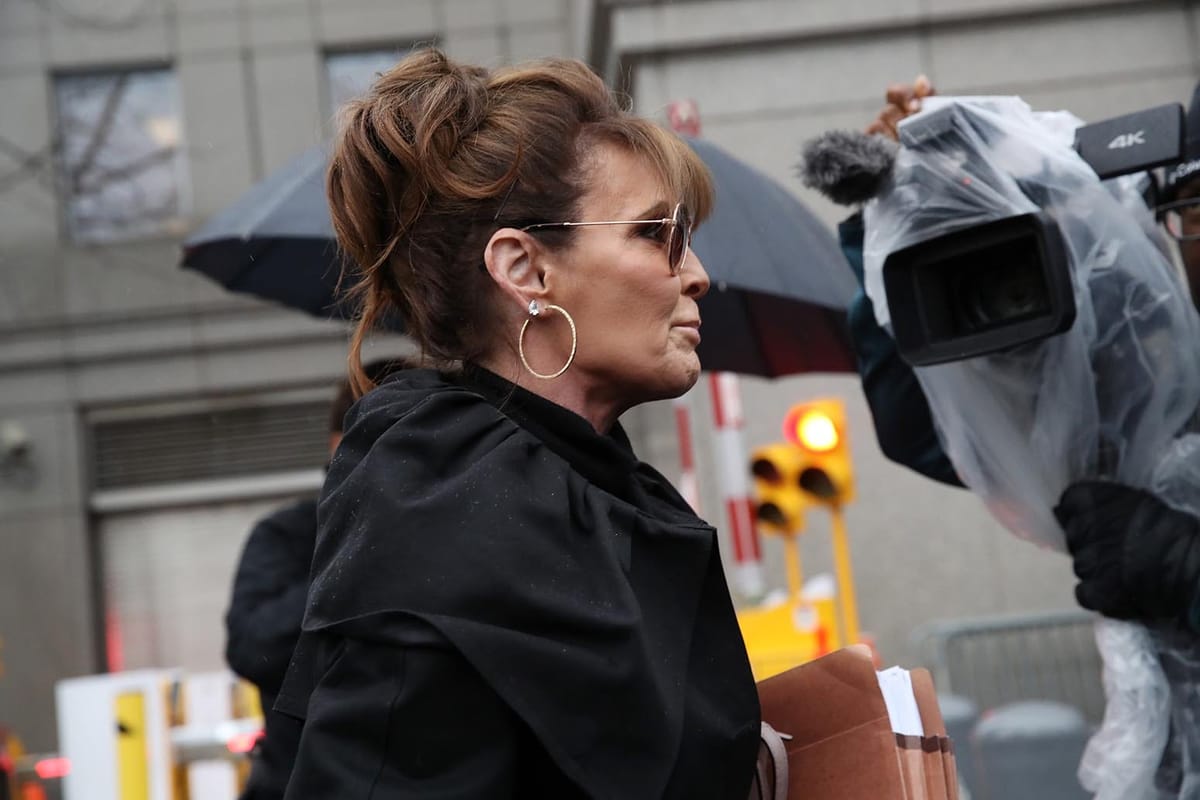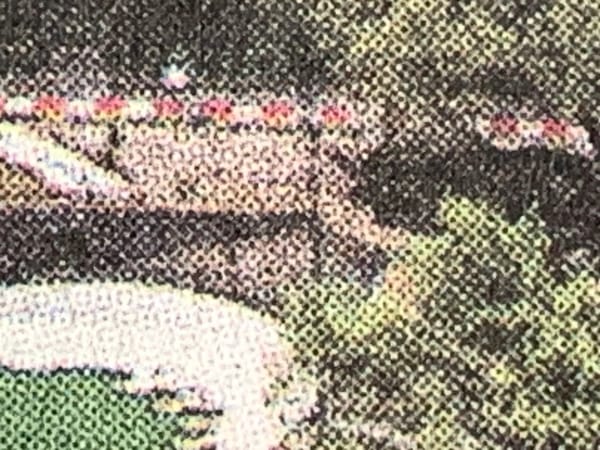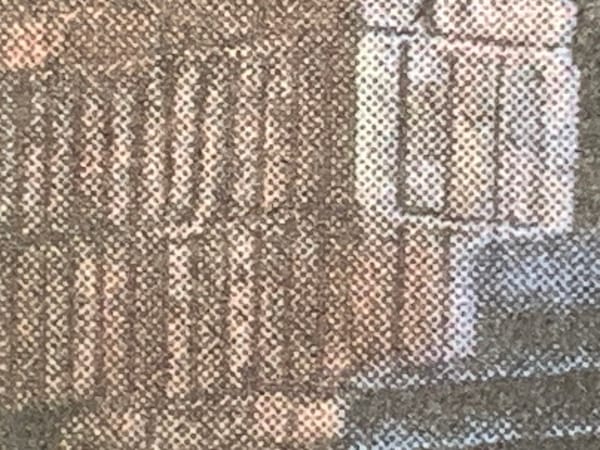Indignity Vol. 2, No. 12: Who loses in Sarah Palin v. the Times?
MEDIA STUDIES DEP'T.

Trial and Error
"I DO NOT like to complain," the former Alaska governor and political celebrity Sarah Palin said, under oath, in a federal courtroom in New York City on Thursday. It was a comical claim, coming from Palin: she was, after all, in the courtroom to complain. Her public career has been more or less entirely built on the spirited recounting of grievances, from her national debut accepting the Republican nomination for vice-president—"If you're not a member in good standing of the Washington elite, then some in the media consider a candidate unqualified for that reason alone"—to her present-day role as the plaintiff in Sarah Palin v. New York Times.
Yet Palin's personal feelings about all those years of her complaining are not provable, so her statement that she doesn't like to complain couldn't technically count as perjury. And whatever else it may turn out to be, as the jury leaves off its deliberations for the weekend to resume Monday morning, Palin v. New York Times has been an ongoing study in the limits and varieties of untruth.
The basic story of the case is that in 2017, the New York Times published an editorial containing a factual claim about Palin that is generally considered to be false. The paper corrected the error the next morning, but Palin still filed a libel suit against the Times and its former opinion editor, James Bennet, who had personally inserted the false claim while revising the editorial.
The larger story of the case is that under New York Times v. Sullivan, the unanimous Supreme Court decision that has defined media law for nearly 60 years, Palin's case should quite obviously be doomed. Under the Sullivan view of the First Amendment, a public figure hoping to win a defamation suit needs to prove that a journalistic outlet acted with "actual malice" by printing a statement that it either certainly knew was false or recklessly failed to check the truth of. Palin is an excruciatingly public figure; the evidence presented at trial documented, in frequently tedious detail, that the Times hammered together the editorial not in active malice but on deadline in a sort of bureaucratic fugue state.
Speaking of malice and of journalistic ethics, I should note here that I have considerable personal and/or professional animosity toward many of the principals on both sides of the trial. Palin's lead lawyers, Shane Vogt and Kenneth Turkel, were part of the legal team on the Bollea v. Gawker lawsuit in 2016, ostensibly pursuing an invasion-of-privacy claim for the former professional wrestler Terry "Hulk Hogan" Bollea but secretly working for the billionaire Peter Thiel in his covert campaign to use abusive litigation to destroy Gawker, my employer at the time. In that trial, which ended in a runaway jury award so large it bankrupted Gawker Media before it could appeal, Vogt and Turkel's team elicited false testimony under oath and generally comported themselves nastily. Merely hearing their hectoring voices in 2022, over the phone feed of the Palin trial, made me strongly consider hanging up and writing about something else.
James Bennet, for his part, published an op-ed piece by Thiel in the Times on the eve of the bankruptcy auction of Gawker Media. In that piece Thiel falsely claimed his crusade was caused by Gawker having outed him, bragged about the public service he'd done by ruining the site, and claimed that "whatever good work it did will continue in the future." In fact, the reputational damage Thiel had done led to Gawker.com being left out of the sale of its sibling websites and being shut down for years; it also effectively made my own equity options in the company worthless. Bennet never corrected any of Thiel's misrepresentations in the piece, even after Thiel publicly contradicted the story that outing had been his motive for targeting Gawker.
So there was a certain bitter glee for me in seeing Bennet—and the Times itself, which greeted the Gawker verdict with a news story headlined "Legal Experts See Little Effect on News Media From Hulk Hogan Verdict"—dragged into court to face exactly the sort of lawsuit they believed was beneath them. Because I consider myself a better person than James Bennet, though, it would pain me to see him lose a case that has no merit, especially to the creeps on the other side and with devastating consequences for every other journalist in the country.
If anything, Palin's complaint against Bennet was flattering to him. It supposed that he deliberately set out to publish a false claim against her. What emerged from the testimony is that Bennet didn't take his work seriously enough for that. To whatever extent journalism and the law are supposed to construct themselves around some core of truth, the trial was one long, dispiriting display of hollowness.
The central untruth in the case was not really a fact but a factoid, in roughly the original sense used by Norman Mailer, who defined factoids as "facts which have no existence before appearing in a magazine or newspaper." The factoid was the notion that in 2011, when a man named Jared Loughner shot Arizona Rep. Gabrielle Giffords and 18 other people, killing six, he had been influenced by a map published by Palin's political action committee, which had superimposed images of gunsights on a selection of Democratic congressional districts, including Giffords'. In the end, the evidence suggested that Loughner was profoundly insane and delusional, and that the map had no relationship to his shooting spree.
But "Sarah Palin targeted Gabrielle Giffords" had lodged itself in the collection of things that people sort of remember having seen in the news at some point. So on June 14, 2017, when James Hodgkinson shot up the Republican practice session for the annual Congressional baseball game, severely wounding Rep. Steve Scalise, it inevitably recalled the Giffords shooting, and the Giffords shooting carried along with it the memory of the untrue Palin connection.
The email chains presented over and over again at trial captured how the editorial board of the Times set about turning these different things—two separate shootings of members of Congress, and a bygone discourse scandal relating to the older of the shootings—into a piece of text in the next day's newspaper, under the headline "America's Lethal Politics." The Times' lead lawyer, David Axelrod, told the jury in his closing remarks that the editorial board saw the Hodgkinson shooting that day as "an important issue that needs to be addressed," but what the emails recounted was the opposite: because the shooting seemed like a thing to be addressed, they needed an important issue to attach to it.
After the discussion feinted at maybe writing about gun control, Bennet steered the board toward making the editorial address the ways that angry political rhetoric fosters a culture of violence, with the Gifford shooting as precedent. When he got a draft, Bennet set about heavily rewriting it, to punch up the message that the attack reflected "a sickeningly familiar pattern" in which "derangement had found its fuel in politics." The resulting fifth and sixth paragraphs read:
Was this attack evidence of how vicious American politics has become? Probably. In 2011, when Jared Lee Loughner opened fire in a supermarket parking lot, grievously wounding Representative Gabby Giffords and killing six people, including a 9-year-old girl, the link to political incitement was clear. Before the shooting, Sarah Palin’s political action committee circulated a map of targeted electoral districts that put Ms. Giffords and 19 other Democrats under stylized cross hairs.
Conservatives and right-wing media were quick on Wednesday to demand forceful condemnation of hate speech and crimes by anti-Trump liberals. They’re right. Though there’s no sign of incitement as direct as in the Giffords attack, liberals should of course hold themselves to the same standard of decency that they ask of the right.
Palin's lawsuit focused on the lines "the link to political incitement was clear" and "there's no sign of incitement as direct as in the Giffords attack," along with the implication that the crosshairs were on Giffords herself, rather than her district. These, she and her lawyers argued, amounted to accusing her of personally causing a mass murder.
The Times, and Bennet in particular, argued that he had meant "incitement" not in the narrow sense of provoking a specific crime, but in the broader sense of inspiring ill will. That was how Thomas Friedman had used it in a Times column Bennet described as inspiration for the "America's Lethal Politics" editorial, comparing Donald Trump's aggressive language at his rallies to the invective heaped on Israeli prime minister Yitzhak Rabin before his assassination in 1995.
The grand and legally inadmissible irony of the case is that everyone knows Sarah Palin is entirely guilty of fostering the politics of belligerence and contempt that have led the Republican Party to its current violent and anti-democratic condition. Palin's selection as a vice-presidential candidate sits on a straight line leading to the angry own-the-libs yahooism in which a nebbish like Marco Rubio could gloat over Trump supporters trying to run a Biden campaign bus off the road, and on from there to January 6.
In Palin's own testimony, as soon as she had introduced herself as a humble and patriotic grandmother quietly living in Wasilla, Alaska, she pivoted to accusing the Times of habitually and intentionally publishing lies about her. Asked what she was referring to—since no examples other than the 2017 editorial had been introduced as evidence—she replied "I don't have specific articles, of course, in front of me." Of course.
But the Times didn’t write the editorial about Palin's record, or even about the general slide of the Republican Party into apocalyptic resentment. What Bennet was doing, as the Washington Post's Erik Wemple observed during the trial, was practicing "the totemic insistence of the mainstream media to filter breaking-news events through insights on 'both sides' of the American political divide." From Bennet's emails, it was clear that he saw the attack on the congressional Republicans, by a gunman who had an apparent left-wing social-media trail, as an answer to existing liberal fears of right-wing violence. The Giffords shooting, with the Palin factoid attached, was treated as a background fact, for ideological symmetry.
Unfortunately for the Times, and now for everyone in the potential blast radius of a verdict, this was all nonsense. The two shootings of Congress members had nothing to do with each other, neither had anything to do with the prevailing violent tendency in American politics, and the claim about the crosshairs map was just wrong.
That last proposition became clear in Bennet's emails not long after the editorial was published online. Ross Douthat, the Times' formerly precocious right-wing columnist, wrote to his boss to express his alarm at the apparent claim about Loughner had been incited by Palin's map, which Douthat remembered was false. Bennet began texting or sending emails to the people who'd worked on the editorial, urging them to figure out what was going on. He had an anxious, sleepless night, he testified (a high-ranking editor at a lesser publication might have gone ahead and spent those hours doing research and publishing a correction), and by late morning the next day, the Times had removed the language about incitement and added its correction:
An editorial on Thursday about the shooting of Representative Steve Scalise incorrectly stated that a link existed between political rhetoric and the 2011 shooting of Representative Gabby Giffords. In fact, no such link was established. The editorial also incorrectly described a map distributed by a political action committee before that shooting. It depicted electoral districts, not individual Democratic lawmakers, beneath stylized cross hairs.
By the Sullivan standard, this all seems straightforward. The Times put a wrong fact in an article, as publications sometimes do. The email trail, revision history, and accompanying testimony from Times staff showed how the article was conceived and how the false fact was inserted, and established that the false fact had slipped through multiple layers of review. When employees realized the fact was wrong, they reacted with alarm, and they moved quickly (by the publication's standards) to correct it. Nowhere in all the communications was there any expression of a desire to damage Sarah Palin's reputation, or even of reckless indifference toward the risk of doing so.
Even so, with the case in the hands of the jury, anything can happen. Still more things can happen beyond that, if Palin loses and appeals, with an eye on the belligerent and contemptuous right-wing supermajority on the Supreme Court. Having lived through the Thiel assault on Gawker, I found myself listening especially sharply to the testimony about Palin's current economic position.
The Times held, reasonably convincingly, that the editorial had not noticeably cost her any opportunities; even so, under questioning she sounded as if the Palin business was growing chilly in the shadows cast by the carnival glow of Trump. Does she do paid speeches? "Haven't in quite a while," she said. She had recorded a promotional video—she rejected the idea that it made her a spokesperson—for something called the American Prosperity Summit. One of the five books that Times lawyers found under her name appeared to be a bootlegged and fraudulently indexed Amazon product. "Didn't write it, didn't read it," Palin said, noting that she would never have chosen the cover picture.
It did not come across as the portfolio of someone well armed for a years-long and unpromising legal fight against an immense and prosperous news company with a policy against settling lawsuits. "There's no version of this that makes Governor Palin a more powerful entity than the New York Times," Turkel told the jury Friday. Yet given Trump's declared goal to "open up our libel laws," and the previously visible connections between Trumpworld, Republican megadonors, and the legal warfare machine assembled by Thiel, it was not that hard to imagine a version of things where the power arrangement behind the trial might look quite different.
Working strictly from the visible evidence, though, Palin's lawyers were left for much of the trial to pick at the ragged edges of the Times' editorial process—as the editorial staff pulled up past stories about the Giffords shooting for research and background, Bennet and others had had ample opportunities to notice or remember that the Palin–Loughner connection had been debunked—or to complain about the paper's manners. The paper had never apologized to Palin, because its press office informed Bennet that the Times does not apologize for corrections. It hadn't put Palin's name in the correction, because Times corrections are supposed to describe the error without restating the false material.
Perversely, even the Times' willingness to make the correction was held as a mark against it. If Bennet hadn't intended "incitement" to mean directly inspiring a crime, Palin's team asked, then why did he agree he'd made a factual error in using that language? The alternative, though, would have been for him to drag his feet and try to package the changes as a "clarification," essentially blaming the readers for not properly understanding the passage.
In the closing remarks, Turkel finally found something that fit within his crosshairs: the editorial itself. Returning to a theme the Palin lawyers had visited before, he asked the jury why, exactly, the piece existed. What was there to the "lethal politics" Bennet had set out to describe, if Loughner was insane and the map had no connection to the violence, and if all the editorial board knew about Hodgkinson came from a few social media posts? What evidence did that leave to support the entire premise of the piece? Bennet, Turkel said, had come up with an idea and "tried to reverse-engineer the facts on it."
In that moment, it was possible to despise Kenneth Turkel, and to believe he was wrong on the law and the principles, and still believe he was onto something. What had been the point of forcing an editorial into the paper, on an urgent deadline, with such a feeble argument behind it? Turkel wanted the jury to believe that the blank space at the center of the editorial marked out the hidden shape of the Times' malice toward Palin. Much more likely, and much more grimly for everyone else, the space where the falsehood had been stood for nothing at all.






